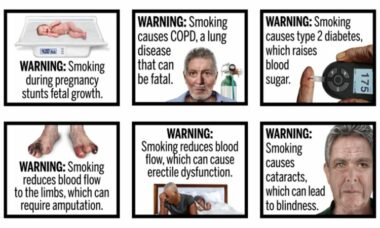 Lawyers for RJ Reynolds Tobacco Company call the US Food and Drug Administration’s (FDA’s) defence of its graphic cigarette warnings “half-hearted” in a new legal brief urging an appellate court to uphold a judge’s ruling that the labels are illegal.
Lawyers for RJ Reynolds Tobacco Company call the US Food and Drug Administration’s (FDA’s) defence of its graphic cigarette warnings “half-hearted” in a new legal brief urging an appellate court to uphold a judge’s ruling that the labels are illegal.
Afer appellate justices in Washington DC said the previous images were “unabashed attempts to evoke emotion (and perhaps embarrassment) and browbeat consumers into quitting”, the FDA revamped the warning labels and tried again.
But instead of making them more neutral, lawyers for RJ Reynolds say, the federal agency “repeatedly accepted recommendations to make the images more emotional and grotesque”. These recommendations came from internal discussions at the FDA and – RJ Reynolds alleges – were made in the hopes the agency could get changes through without a problem.
“The FDA’s tactics are akin to the ‘shock-and-awe’ advocacy used in numerous ideological debates, such as when animal-rights activists display photographs of mutilated animals,” according to the 82-page brief filed 12th July with the US Court of Appeals for the Fifth Circuit.
The brief responds to the FDA’s appeal of US district judge J. Campbell Barker’s 7th December 2022 decision to grant summary judgement (a judgement without a full trial) on a First Amendment claim in favour of RJ Reynolds and eight other plaintiff companies, Santa Fe Natural Tobacco Company, ITG Brands, Liggett Group, Neocom, Rangila Enterprises, Rangila, Sahil Ismail, and Is Like You.
Barker said the FDA had “not shown that compelling these large, graphic warnings is necessary in light of other options”.
‘The FDA’s bottom line is genuinely startling’
The FDA defended the warnings in its appellate brief filed 11th May with the Fifth Circuit, saying the rule allowing the warnings “fully accords with the First Amendment”.
“There should be little doubt as to the validity of the textual warning statements required by the rule, which convey undisputed facts about the negative health consequences of smoking,” according to the brief, which argues that Barker “misunderstood” the legal analysis and case record when he declared the warnings were not factual.
Lawyers for RJ Reynolds say the FDA’s argument ignores an important debate about the effectiveness of the warnings on public health.
The rule that allows the warnings was issued on 18th March 2020, after the US Court of Appeals for the DC Circuit struck down the first version of the rule in 2012 because the FDA didn’t provide a “shred of evidence” that it would reduce smoking.
But rather than defending the new rule’s public health benefits, the FDA is ignoring the public health issue and focusing only on the First Amendment. The 12th July RJ Reynolds response brief, signed by lawyer Ryan Watson, a partner at Jones Day, said that when considering all FDA arguments, “the FDA’s bottom line is genuinely startling”.
According to the response: “The FDA believes it could require any product or advertisement to include large, disturbing, and misleading graphic warnings in the service of ‘informing’ the public of the government’s messages. No product or advertisement would be safe – because the government could always pick a more obscure piece of information to convey.”
The FDA has until 16th August to file its reply brief.
‘A grave constitutional violation’
RJ Reynolds is supported by the Association of National Advertisers, which filed a 38-page amicus brief on 21st July with Summus 2, which manages commercial billboards in cities across the US. The brief said the government is allowed to opine about the risks of smoke, but “it may not force private parties to disseminate its text and images outside the context of combatting a deceptive message”.
Altria Group filed an amicus brief as well, on 19th July, supporting the plaintiffs who “have long displayed text-only warnings the Surgeon General developed regarding smoking-related health risks”. But, the brief says, the new warnings the FDA wants to mandate force cigarette makers “to disparage their own products with inflammatory and misleading graphic warnings”.
The plaintiff companies also have a supporting amicus brief from the Washington Legal Foundation, which says no legal holdings suggest that “the government may commandeer a business into serving as an involuntary mouthpiece for controversial viewpoints it opposes – much less as a billboard for discouraging consumers from buying its goods,” and that to do so would be “a grave constitutional violation under any level of constitutional scrutiny”.
The FDA, meanwhile, has its own supporting amicus briefs from the Public Health Law Center, Public Citizen Litigation Group (a Washington DC-based public interest law firm), and a collection of advocacy groups made up of the American Academy of Family Physicians, the American Academy of Pediatrics, the American Cancer Society, the American Cancer Society Cancer Action Network, the American Heart Association, the American Lung Association, the American Medical Association, the Campaign for Tobacco-Free Kids, the Texas Medical Association, and Truth Initiative.
The brief from the advocacy groups says the graphic warnings “would materially enhance the efforts of [the groups] to educate the public about the health harms of smoking”.
– Meghann Cuniff TobaccoIntelligence US legal correspondent







